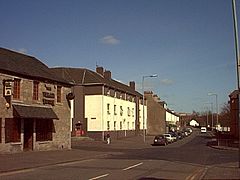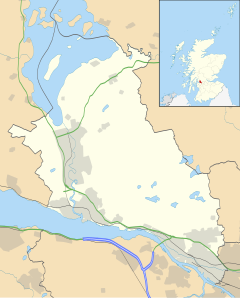Duntocher
| |
|---|---|
 Main Street, Duntocher | |
Location within West Dunbartonshire | |
| Population | 6,680 (2022)[1] |
| OS grid reference | NS490730 |
| Council area | |
| Lieutenancy area | |
| Country | Scotland |
| Sovereign state | United Kingdom |
| Post town | CLYDEBANK |
| Postcode district | G81 6 |
| Dialling code | 01389 |
| Police | Scotland |
| Fire | Scottish |
| Ambulance | Scottish |
| UK Parliament | |
| Scottish Parliament | |
Duntocher (Scottish Gaelic: Dùn Tòchair or Druim Tòchair) is a village in West Dunbartonshire, Scotland. It has an estimated population of 6,850.[2] The etymology of the name of the village indicates that its name means "the fort on the causeway".[3]
Duntocher has effectively become a northern suburb of the nearby town of Clydebank, as have neighbouring Hardgate and Faifley. Duntocher expanded due to housebuilding by Clydebank Burgh Council after the Second World War, although the area was never formally absorbed into the burgh. When burghs were abolished by local government reorganisation in 1975, however, Duntocher was included in the larger Clydebank District, which existed until the creation of West Dunbartonshire in 1997. Further housing was built by the Wimpey firm in the late 1960s and early 1970s, on what had been green belt land. Along with Faifley and Hardgate, Duntocher falls within West Dunbartonshire's Kilpatrick ward with a combined population of 12,719 in 2011.[4]
At one time this was the most north westerly point on the Glasgow Corporation Transport tram system, trams operating from here via Hardgate to Clydebank, and at times, on to Partick depot.
Duntocher historically had several cotton and corn mills, driven by the Duntocher Burn which is the traditional boundary between Duntocher and neighbouring village Hardgate.
The Antonine Wall also runs through the village, and ancient Roman fortifications are still visible in the local Goldenhill Park.[5] Lottery funding is to provide funds for a children's playpark at Goldenhill.[6] Sir George Macdonald wrote about the findings at Duntocher.[7]
Duntocher has a Roman Catholic church – St. Mary's, a United Free Church of Scotland – Duntocher West, and a Church of Scotland – Duntocher Trinity. The village also has one Roman Catholic primary school – St Mary's and one non-denominational, Carleith Primary School.
The village has a main street (Dumbarton Road) which acts as the main focal point for village activity. The majority of the villages shops and pubs, the cafe and the local churches and village halls are located along or very close to a small stretch of this road
The village is at the southern edge of the Kilpatrick Hills.
- ^ "Mid-2020 Population Estimates for Settlements and Localities in Scotland". National Records of Scotland. 31 March 2022. Retrieved 31 March 2022.
- ^ "Duntocher in West Dunbartonshire (Scotland)". CITY POPULATION. Retrieved 2 December 2017.
- ^ "DUNTOCHER: FORT, FORTLET AND BATH-HOUSE" (PDF). Frontiers of the Roman Empire. Retrieved 26 November 2017.
- ^ Kilpatrick Central Ward - Area Profile, West Dunbartonshire Council
- ^ "The Antonine Wall Management Plan 2014-19" (PDF). Antonine Wall. Retrieved 28 April 2018.
- ^ "Antonine Wall project awarded £980,000 funding from National Lottery". West Dunbartonshire Council. 4 October 2018. Retrieved 6 October 2018.
- ^ Macdonald, Sir George (1934). The Roman wall in Scotland, by Sir George Macdonald (2d ed., rev., enl., and in great part rewritten ed.). Oxford: The Clarendon press. pp. 228–232. Retrieved 11 October 2017.
